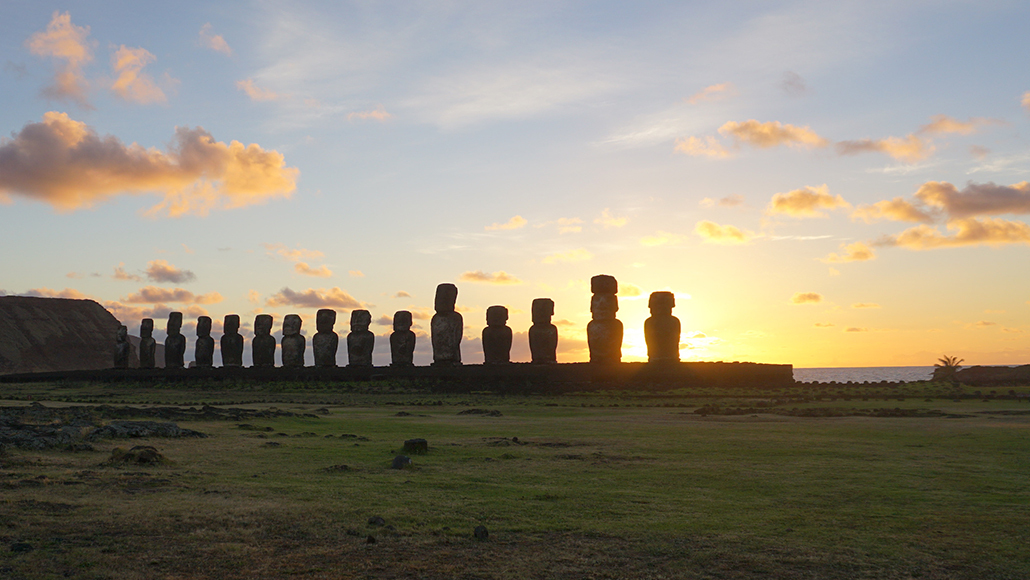
Ancestors of the people who built massive statues on Easter Island possessed ancestry acquired from South Americans around 800 years ago, a new study of DNA concludes.
A. Moreno-Estrada
More than 800 years ago, Indigenous people in South America traversed more than 7,000 kilometers of open sea to reach eastern Polynesia, a new study suggests.
There, the South Americans mated with Polynesian inhabitants during the initial period of discovery and settlement of those remote islands, researchers say. Genetic analyses show that initial DNA swaps between the voyagers and people on a still-undetermined eastern Polynesian island were followed by the spread of the South American ancestry to other eastern Polynesian islands.
Eventually that ancestry spread as far east as Easter Island, also known as Rapa Nui, a team led by computational biologist Alexander Ioannidis and population geneticist Andrés Moreno-Estrada reports online July 8 in Nature.
The study offers the first genetic glimpse of “a prehistoric event that left no conclusive trace, except for the one recorded in the DNA of those who had contact 800 years ago in one of the most remote places on Earth,” says Moreno-Estrada, of the National Laboratory of Genomics for Biodiversity in Irapuato, Mexico.
Ideas about how remote Polynesia came to be populated have long inspired scientific debate. Norwegian explorer Thor Heyerdahl’s 1947 Kon-Tiki expedition tested his idea that South American seafarers settled the Pacific islands, including Rapa Nui, showing that it was possible to drift by wooden raft from about 129 kilometers off Peru’s coast to Polynesia. But most scholars at that time assumed Asians had voyaged east as early as around 3,500 years ago to relatively close-by western Polynesia, eventually populating eastern Polynesia by around 1,000 years ago without having any contacts with people from South America.
Computer simulations since have indicated that winds and currents would carry a vessel from northern South America to the Polynesian islands. But the idea of seafaring South Americans having an early role in the peopling of Polynesia hasn’t been widely accepted.
It’s unknown, for example, whether such groups in the Americas had seagoing vessels or the navigational skills needed to reach Polynesia, says anthropologist and population geneticist John Lindo of Emory University in Atlanta.
Ioannidis, of Stanford University, and Moreno-Estrada’s group searched for molecular markers of shared ancestry in DNA of 807 individuals from 17 island populations in Polynesia and 15 Indigenous groups from relatively near Central and South America’s Pacific coast. Genetic data included 166 Rapa Nui inhabitants and 188 individuals from other Pacific islands. All DNA came from present-day people except for samples from four individuals, each from a different site in the Americas. Those ancient individuals lived between around 500 and 7,400 years ago.
Comparisons of the length of DNA segments shared by Polynesians and Indigenous peoples from the Americas enabled calculations of when Indigenous American DNA was first introduced to Polynesian groups. Smaller DNA segments are assumed to represent older instances of mating across populations than longer segments due to the breakdown of shared segments in later generations.
DNA resembling that of Indigenous people now living in Colombia appeared on an island called Fatu Hiva in the southern Marquesas Islands by around 1150, probably the result of a single ancient contact, the researchers estimate. The South American ancestry reached three nearby sets of eastern Polynesian islands between roughly 1200 and 1230, followed by Rapa Nui in around 1380. The genetic data can’t establish which Polynesian islanders mated with the South Americans before spreading that ancestry elsewhere in the Pacific, only that evidence so far points to the southern Marquesas.
But other contact scenarios between Polynesians and South Americans exist. The new study provides genetic support for a scenario in which ancestors of Rapa Nui settlers traveled to South America and possibly returned with sweet potatoes, says archaeologist Carl Lipo of Binghamton University in New York. Those ancestors then could have carried that crop and South American DNA to a majority of eastern Polynesian islands, he says. Some scientists have previously suggested that Polynesians traveled to and from South America, bringing the sweet potato to eastern Polynesia more than 800 years ago (SN: 4/12/18) and possibly chickens to the Americas more than 600 years ago (SN: 6/5/07).
Ancient Polynesians’ “tremendous navigation skills” would have made possible round trips to South America, Lindo agrees.
Radiocarbon dating of archaeological remains and linguistic studies suggest that people reached Rapa Nui by around 1200, nearly 200 years before the newly estimated arrival of Polynesians with South American ancestry, archaeologist Paul Wallin writes in a commentary published with the new study. Trade and cultural exchanges may have connected Rapa Nui to South America before DNA did, suggests Wallin, of Uppsala University in Sweden.
Only a larger genetic study can resolve whether South Americans voyaged to Polynesia or vice versa, Moreno-Estrada says.






